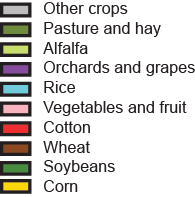Bensulide
ben-suh-lyd
Primarily used on vegetables and fruit. Registered as a U.S. pesticide in 1991. Reregistered in 2006. Currently under registration review.
Overview
Bensulide is used in 10 states.

Bensulide is used in Arizona, California, Illinois, Indiana, Kentucky, Minnesota, Nevada, New Mexico, Texas, and Wisconsin.
Data is not available for Alaska, D.C., Hawaiʻi, and U.S. Territories. Data represents the most recent year available from USGS. Details.
See detailed maps of bensulide usage by state and county.
Human Health Effects
Even at low levels of exposure, bensulide can lead to serious negative health effects.
Neurodevelopmental Harm
Reproductive Toxicity
High Risk Exposure Routes
People are exposed to bensulide through food and drinking water, even if they don’t live near areas where pesticides are sprayed. Details.
Food and/or Drinking Water
FarmworkersPeople performing post-application activities in previously treated fields, but do not directly apply pesticides themselves. Details.
Pesticide HandlersPeople involved in pesticide application process. Details.
Residential
Residential BystanderPeople who live near areas where pesticides are applied. Details.
Spray Drift
High Residue Foods
Where residue levels of bensulide exceeded allowable limits or were not legally allowed to have residues. Details.
[No high residue foods were specifically identified from the USDA's PDP database. ]
No detection does not necessarily mean there are no residues of concern. A relatively small sample of food products is tested and not all organophosphate pesticides are tested for.
Moreover, current U.S. pesticide tolerance levels are not protective against neurodevelopmental harm in children, so detections at or below tolerance levels do not indicate no harm.
Registered Uses
Where EPA allows bensulide to be used.
Agricultural Crops: fruit and vegetables
Golf Courses
Residential Turf
Additional Information
Estimated Use of Bensulide on Crops
Most recent agricultural crop usage data as provided by the U.S. Geographical Survey’s Pesticide National Synthesis Project. Does not reflect universal usage of bensulide. (How do EPest-low and EPest-high differ?)
U.S. Tolerances Categories & Commodities for Bensulide
The U.S. EPA sets maximum residue limits — known as “tolerances” — on the amount of bensulide that may remain in and on foods. The tolerance is the residue level that triggers enforcement actions.
Tolerances have been set for bensulide for: Agricultural Commodities. Maximum residue limits have been set for bensulide by the U.S. EPA for the following commodities:
Leafy Vegetables
Onion
Roots
U.S. EPA Human Health Risk Assessments for Bensulide
Human Health Risk Assessments are conducted by the U.S. EPA to estimate the nature and probability of harmful health effects in people who may be exposed to pesticide. They are used to make informed decisions about approving new pesticides and new uses of registered pesticides, and during our regular review of existing pesticides. Read the assessment for bensulide.


